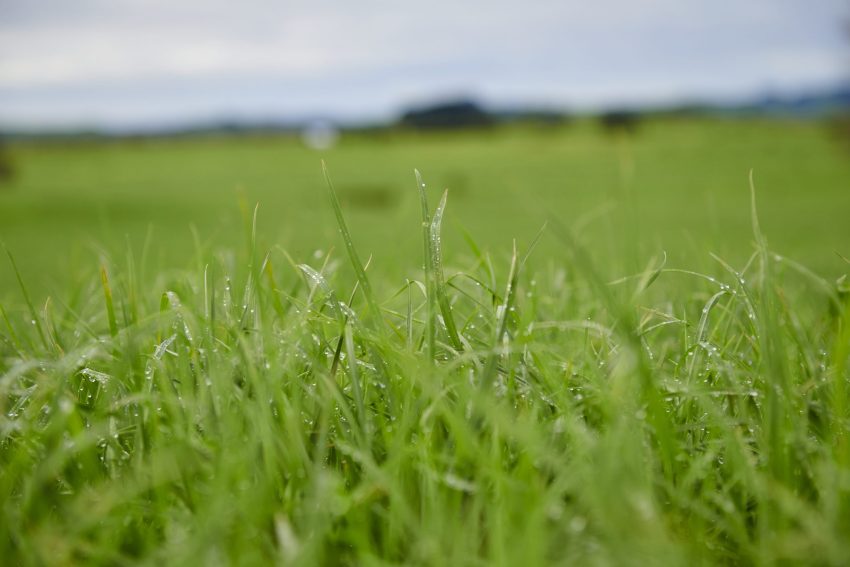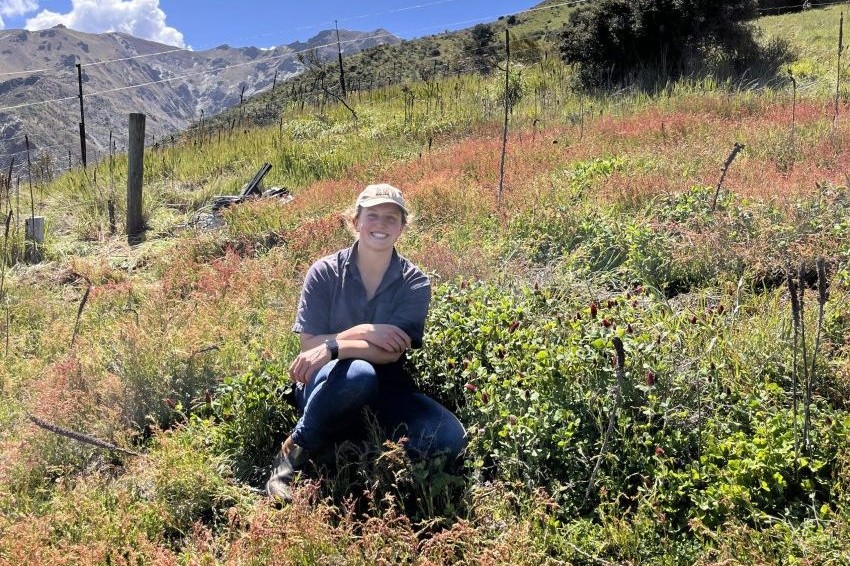Elaine Fisher
Taking paddocks out of grazing rotation for three months, especially when trying to maintain pasture quality in spring, may seem counterintuitive, but research by DairyNZ and AgResearch has demonstrated significant benefits from deferred grazing.
Katherine Tozer of AgResearch and Wendy Griffiths of DairyNZ have been involved in separate research trials investigating a system which was part of farming in the days when haymaking and lower stocking rates were the norm.
Both scientists are impressed with the benefits of deferred grazing for drystock and dairy farmers including increased pasture density and resilience, and cost savings from not making or buying in feed or under-sowing pasture.
Deferred grazing or summer fallow takes ryegrass-based pasture paddocks out of the grazing rotation over late spring and summer to allow the ryegrass to flower and re-seed and build root reserves before being grazed in autumn.
Typically carried out on hill country where mechanical harvesting of surpluses is impossible, taking a paddock out of rotation allows grazing to be concentrated and therefore pasture quality retained on the balance of the farm.
Wendy’s research began in March 2018, when DairyNZ started a plot-scale trial at Scott Farm, near Hamilton. The aim was to look at ways of recovering perennial ryegrass populations through grazing management.
Through discussions with a group of Waikato dairy farmers, two management interventions were identified: extending the spring grazing rotation and deferred grazing of pasture in spring and summer. These were compared with two other management interventions: autumn under-sowing, and current best practice spring and summer management.
“Deferred grazing is a viable option for rye grass pasture regeneration. It allows the recovery of the tiller population and the shedding of seeds to recruit new plants. There are also cost savings from not having to under-sow,” Wendy says.
“My observations are that a mass of seedlings become established under the mulch and that mulch, in a drought situation, helps retain soil moisture.
“During our trial period we did not have a great deal of rain, maybe just three to four small events, but each time it rained we got a new strike of plants as soil moisture had been retained. We also observed a good spread of new plants across the pasture.”
Another advantage of the system could be a reduction in soil degradation due to cropping.
“Seed sales data indicate that 30,000 to 50,000ha has moved to annual crops and pasture in NZ since 2007. From what farmers are telling us we believe that some of this increase is due to failure of perennial pasture to persist. This is a significant cost and also carries an increased risk of lasting damage to soils.”
Wendy acknowledges there is some concern among farmers around facial eczema levels.
“This is a legitimate concern and the potential for increased spore levels is something farmers should be aware of. However, we did not have a problem during the trial in 2018-19 because it was under drought conditions.”
Wendy says while there is more research to do DairyNZ will produce a simple manual to help inform onfarm decisions about how to implement deferred grazing.
Katherine Tozer says AgResearch was interested in finding ways to improve pasture persistence and resilience, its recovery from drought, uneven rainfall, insect pressures and grazing stress.
“I was aware of earlier research looking at the agronomics of deferred grazing which is critical but also wanted to look at what goes on inside the plant and how that affects the tiller pattern and the plant’s lifecycle.
“In most NZ farms we treat the plant as if it is in a vegetative state all the time and do not allow it to complete its lifecycle, but we don’t do that with anything else on the farm.”
Through the Sustainable Farming Fund project, “Farming in a Volatile World”, two Bay of Plenty hill country sheep and beef farmers – Allen Coster from Kaimai and Rick Burke from Katikati and the summer dry farm owned by John Sherlock of west Waikato worked alongside AgResearch, Ballance Agri-Nutrients, Plant & Food Research, Bay of Plenty and Waikato Regional Councils and Beef + Lamb New Zealand to quantify the impact deferred grazing has on pasture cover and quality, soil properties, root mass and farm finances.
The trial included a glasshouse study simulating deferred grazing, which showed the plants developed three times the amount of root mass and deeper roots, compared with the control.
“We ran two parallel sets of experiments and assumed that what we saw in the glasshouse was similar to what happened in the pasture. The results of extra root mass is better survival and regrowth after drought,” says Katherine.
“Under current farming methods we have been pushing the system. Letting the plants flower is taking the foot off the pedal and working with the plant’s lifecycle to produce more tillers, but this is also a whole different mindset for some farmers.” Not grazing some paddocks allows the ryegrass to flower and seed. It also increases grazing pressure on the rest of the farm which helps to maintain high quality pastures in late spring and into the summer.
Katherine says when pasture is re-opened it needs to be treated like new pasture – to be grazed off to let in light and encourage new tillers and seedlings to grow.
The potential for increased facial eczema
spores is a concern. “We have done two field studies. One in a wet year and one in a dry year. Both studies showed there was either lower or similar levels of spores to normal pasture. We have found no evidence that deferred grazing increases facial eczema, but it is still possible spores may go above the safe level so farmers using deferred grazing should be aware of that potential.”
While it may be hard to leave a paddock locked up when feed elsewhere is short, Katherine says if there is a need to open deferred pastures early that can be done, but the biggest benefits come from holding out for extra tillering and production down the track.
The results of the research showed that pasture quality was maintained in grazed paddocks. Paddocks that were deferred (not grazed from November until the end of summer) had greater pasture production in the year after deferring.
Those pastures also had greater perennial ryegrass tiller densities 18-24 months after deferring and greater ground cover in the year of deferring.
Greater ryegrass root mass and tillering (in an aligned glasshouse study in which plants were manually trimmed to simulate regular grazing or deferred) were also recorded. Farm profitability was shown to be greater too, (at least in the Farmax model developed by Steven Howarth from AgFirst).
Karin Müller from Plant & Food Research found that some soil parameters including bulk density, total porosity, mineral-N and anaerobically mineralisable nitrogen showed a short-term improvement after deferring.
“Next we’d like to investigate the impact of deferred grazing on runoff and sediment loss and the impact of the greater root mass on nutrient leaching,” Katherine says.
“We do not know the impact on N or P runoff but potentially the environmental impact could be biologically significant, considering the positive effects of deferred grazing on ground cover and soil structure.”
Katikati dry stock farmer and 2014 Bay of Plenty Ballance Farm Environment Awards supreme winner, Rick Burke says deferred grazing was a saviour for Pukekauri Farms this summer.
“This is the driest summer I have known since farming here. Creeks dried up and we had to really juggle grazing management.
“A lot of the deferred grazing principles were part of the way we farmed years ago. Now there is much talk about regenerative agriculture and deferred grazing fits exactly with that,” Rick says.
“For me it’s a simple low-cost, carbon-friendly and low-stress way of maintaining quality in the late spring by shutting up paddocks and shifting the surplus feed to be grazed at a time of need in late summer early autumn.
“Deferred grazing is a tool that helps take the stress out of a drought situation. I have shut-up 10% of my farm which means I can break feed the deferred grazing with dairy heifers or store cattle leaving a large area of the farm to recover from the drought.
“It’s a great way to rejuvenate damaged paddocks and the big benefit is that you will grow up to 25% more grass in the deferred paddocks the following spring.”
Rick is committed to using deferred grazing as a management tool, selecting paddocks not suitable for making hay or silage, and those which have been pugged by stock, and as a result, have a lot of weeds.
“We have also introduced other herbs into the pastures, including plantain, clover, Balansa clover, radish, chicory and vetch which we over-sow, then break feed using the young stock to walk seeds in.”
Allen Coster, who farms in the Kaimai Ranges and has also won Ballance Farm Environment awards, was keen to be part of Katherine Tozer’s trial work on deferred grazing, after he heard her give an address at a Grassland conference.
“I’m a fan of deferred grazing because of the huge benefits it offers. When we came out of drought, I had all that feed ready to go.
“Buying in or making feed at 45 cents or more a kg of dry matter is not viable for sheep and beef farmers,” Allen says.
He targeted paddocks that had suffered pugging and where ewes and lambs had been grazed in the late spring. “This form of integrated grazing helped keep internal parasites at bay and gave us a worm free pasture in the following autumn, when we re-opened the paddocks to dairy heifers which are good at mowing down that sort of feed.
“We had good weight gain from the stock. I plan to reduce the number of dairy heifers I graze in future and shut up 20 to 25% of the farm for deferred grazing.”




